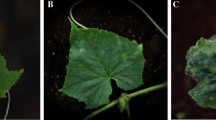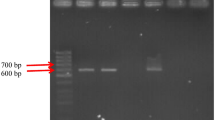Abstract
Cucumber mosaic virus (CMV) was found by reverse transcription polymerase chain reaction (RT-PCR) to be not fully systemic in naturally infected kava (Piper methysticum) plants in Fiji. Twenty-six of 48 samples (54%) from various tissues of three recently infected plants were CMV-positive compared with 7/51 samples (14%) from three long-term infections (plants affected by dieback for more than 1 year). The virus was also found to have a limited ability to move into newly formed stems. CMV was detected in only 2/23 samples taken from re-growth stems arising from known CMV infected/dieback affected plants. Mechanical inoculation experiments conducted in Fiji indicate that the known kava intercrop plants banana (Musa spp.), pineapple (Ananas comosus), peanut (Arachis hypogaea) and the common weed Mikania micrantha are potential hosts for a dieback-causing strain of CMV. It was not possible to transmit the virus mechanically to the common kava intercrop plants taro (Colocasia esculenta), Xanthosoma sp., sweet potato (Ipomoea batatas), yam (Dioscorea alata), papaya (Carica papaya) or the weed Momordica charantia. Implications of the results of this research on a possible integrated disease management strategy are discussed.
Similar content being viewed by others
References
Anon. (2001 ) ‘Pacific kava a producer’s guide.’ (Secretariat of the Pacific Community: Fiji)
Anon. (2003) Kava dieback disease. Plant Protection Service, Secretariat of the Pacific Community, Farmer Advisory Leaflet No. 1, Fiji.
Bariana HS, Shannon AL, Chu PWG, Waterhouse PM (1994) Detection of five seedborne legume viruses in one sensitive multiplex polymerase chain reaction test. Phytopathology 84, 1201–1205.
Bos L, Maat DZ (1974) A strain of cucumber mosaic virus, seed-transmitted in beans. Netherlands Journal of Plant Pathology 80, 113–123.
Brunt AA, Jackson GVH, Frison EA (Eds) (1989) ‘FAO/IBPGR technical guidelines for the safe movement of yam germplasm.’ (Food and Agriculture Organisation of the United Nations, Rome/International Board for Plant Genetic Resources: Rome)
CABI (2002) ‘Crop protection compendium.’ (CAB International: Wallingford, UK)
Carrère I, Tepfer M, Jacquemond M (1999) Recombinants of cucumber mosaic virus (CMV): determinants of host range and symptomatology. Archives of Virology 144, 365–379. doi: 10.1007/s007050050510
Dale JL, Harding RM (1998) Banana bunchy top disease: current and future strategies for control. In ‘Plant virus disease control’. (Eds A Hadidi, RK Khetarpal, H Koganazawa) pp. 659–669. (APS Press: St Paul, USA)
Davis RI (1999) Kava dieback. Secretariat of the Pacific Community Pest Advisory Leaflet No. 25, Fiji.
Davis RI, Brown JF (1996) Epidemiology and management of kava dieback caused by cucumber mosaic cucumovirus. Plant Disease 80, 917–921.
Davis RI, Brown JF (1999) Kava (Piper methysticum) in the South Pacific: its importance, methods of cultivation, cultivars, diseases and pests. Australian Centre for International Agricultural Research Technical Report No. 46, Canberra.
Davis RI, Brown JF, Pone SP (1996) Causal relationship between cucumber mosaic cucumovirus and kava dieback in the South Pacific. Plant Disease 80, 194–198.
Douine L. Quitot JB. Marchoux G. Archange P (1979) Recensement des espèces végétales sensibles au Virus de la Mosaïque du Concombre (CMV) Etude bibliographique. Annales de Phytopathologie 11, 439–475.
Egan BT, Ryan CC, Francki RIB (1989) Fiji disease. In ‘Diseases of sugarcane major diseases’. (Eds C Ricaud, BT Egan, AG Gillespie, CG Hughes) pp. 263–288. (Elsevier: Amsterdam)
Fargette D, Vie K (1995) Simulation of the effects of host resistance, reversion, and cutting selection on yield losses in cassava. Phytopathology 85, 370–375.
Frison EA, Bos L, Hamilton RI, Mathur SB, Taylor JD (Eds) (1990) ‘FAO/IBPGR technical guidelines for the safe movement of legume germplasm.’ (Food and Agriculture Organisation of the United Nations, Rome/International Board for Plant Genetic Resources: Rome)
Garnsey SM, Gottwald TR, Yokomi RK (1998) Control strategies for Citrus tristeza virus. In ‘Plant virus disease control’. (Eds A Hadidi, RK Khetarpal, H Koganazawa) pp. 639–658. (APS Press: St Paul, USA)
Gatty R (1956) Kava-Polynesian beverage shrub. Economic Botany 10, 241–249.
Hu JS, Li HP, Barry K, Wang M, Jordan R (1995) Comparison of dot blot, ELISA, and RT-PCR assays for detection of two cucumber mosaic virus isolates infecting banana in Hawaii. Plant Disease 79, 902–906.
Kegler H, Hartmann W (1998) Present status of controlling conventional strains of Plum pox virus. In ‘Plant virus disease control’. (Eds A Hadidi, RK Khetarpal, H Koganazawa) pp. 616–629. (APS Press: St Paul, USA)
Kennedy JS, Booth CO, Kershaw JS (1959) Host finding by aphids in the field. II. Aphis fabae Scop. (Gynoparae) and Brevicoryne brassicae L.; with a re-appraisal of the role of host-finding behaviour in virus spread. Annals of Applied Biology 47, 424–444.
Kumar S, Kaitetara T, Mudaliar T (1998) ‘Opportunities for the production of yaqona in Fiji for export. Situation analysis No. 1.’ (Ministry of Agriculture, Forestry and Fisheries and Soil Evaluation Project: Fiji)
Lebot V Merlin M, Lindstrom M (1992) ‘Kava the Pacific drug.’ (Yale University Press: Newhaven)
Marathe R, Anandalakshmi R, Smith TH, Pruss GJ, Vance VB (2000) RNA viruses as inducers, suppressors and targets of post-transcriptional gene silencing. Plant Molecular Biology 43, 295–306. doi: 10.1023/A: 1006456000564
Parham BEV (1935) Wilt disease of ‘yangona’. Fiji Agricultural Journal 8, 2–8.
Perry KL, Zhang L, Palukaitis P (1995) Differential transmission of cucumber mosaic virus by two aphids: mutations in the coat protein restore transmission by Aphis gossypii but not by Myzus persicae. Phytopathology 85, 1143.
Roossinck MJ (2001) Cucumber mosaic virus, a model for RNA virus evolution. Molecular Plant Pathology 2, 59–63. doi: 10.1046/j. 1364-3703.2001.00058.x
Sharman M, Thomas JE, Dietzgen RG (2000) Development of a multiplex immunocapture PCR with colourimetric detection for viruses of banana. Journal of Virological Methods 89, 75–80. doi: 10.1016/SO 166-0934(00)00204-4
Singh YN (1992) Kava: an overview. Journal of Ethnopharmacology 37, 13–45. doi: 10.1016/0378-8741(92)90003-A
Singh Z, Jones RAC, Jones MGK (1995) Identification of cucumber mosaic virus subgroup I isolates from banana plants affected by infectious chlorosis disease using RT-PCR. Plant Disease 79, 713–716.
Smith MC, Holt J, Kenyon L, Foot C (1998) Quantitative epidemiology of Banana bunchy top virus disease and its control. Plant Pathology 47, 177–187.
Sulistyowati E, Mitter N, Bastiaan-Net S, Roosinck MJ, Dietzgen RG (2004) Host range, symptom expression and RNA 3 sequence analyses of six Australian strains of Cucumber mosaic virus. Australasian Plant Pathology 33, 505–512. doi: 10.1071/AP04054
Thomson D, Dietzgen RG (1995) Detection of DNA and RNA plant viruses by PCR and RT-PCR using a rapid virus release protocol without tissue homogenization. Journal of Virological Methods 54, 85–95. doi: 10.1016/0166-0934(95)00022-M
Thresh JM, Otim-Nape GW, Fargette D (1998) The control of African cassava mosaic disease: phytosanitation and/or resistance? In ‘Plant virus disease control’. (Eds A Hadidi, RK Khetarpal, H Koganazawa) pp. 670–677. (APS Press: St Paul, USA)
Author information
Authors and Affiliations
Corresponding author
Rights and permissions
About this article
Cite this article
Davis, R.I., Lomavatu-Fong, M.F., McMichaef, L.A. et al. Cucumber mosaic virus infection of kava (Piper methysticum) and implications for cultural control of kava dieback disease. Australasian Plant Pathology 34, 377–384 (2005). https://doi.org/10.1071/AP05050
Received:
Accepted:
Issue Date:
DOI: https://doi.org/10.1071/AP05050




